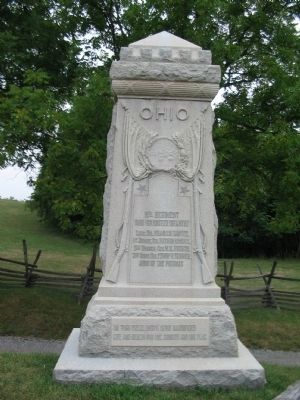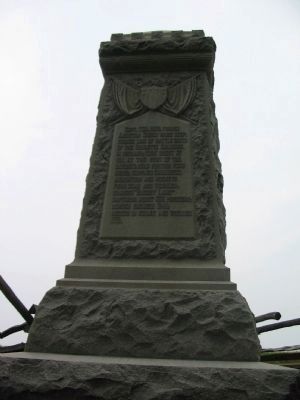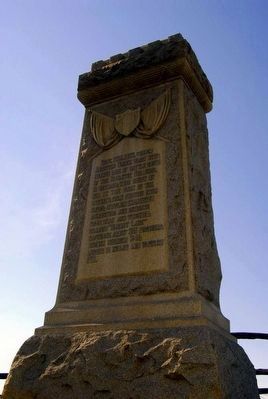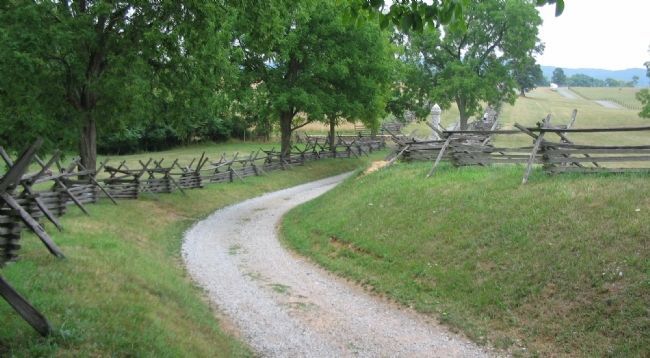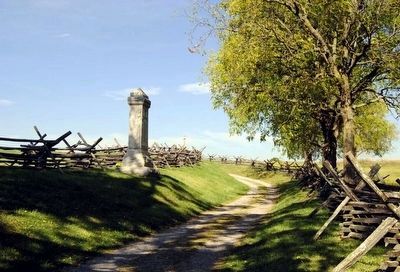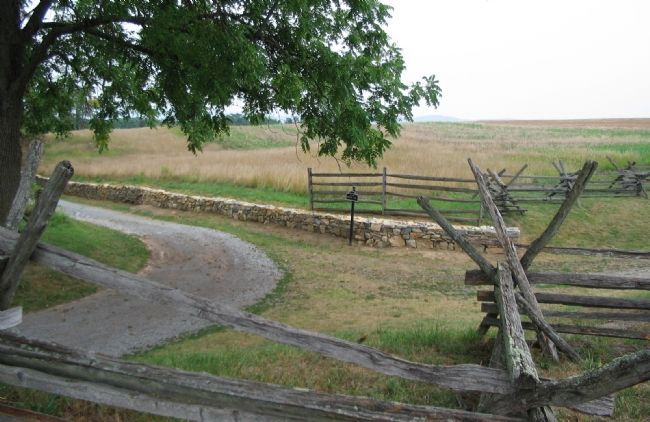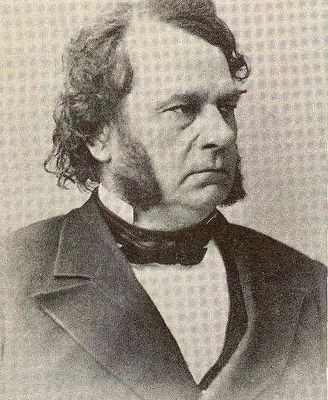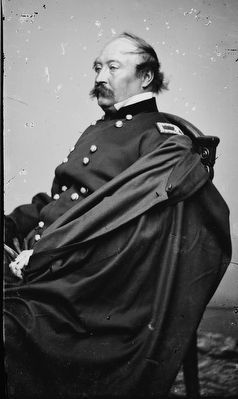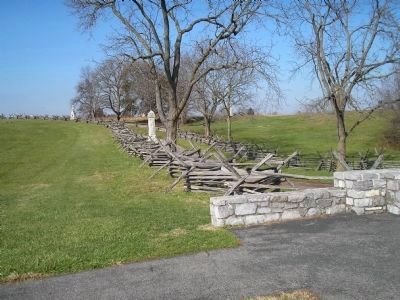Near Sharpsburg in Washington County, Maryland — The American Northeast (Mid-Atlantic)
8th Ohio Regiment
Ohio Volunteer Infantry
Lieut. Col. Franklin Sawyer
1st Brigade Gen. Nathan Kimball
3rd Division Gen. W. H. French
2nd Corps, Gen. Edwin V. Sumner
Army of the Potomac
On this field Ohio's sons sacrificed
life and health for one country and one flag.
(Rear):
Antietam Creek waist deep;
formed line of battle South
of the Roulette buildings,
in orchard, took crest of
hill at the point of the
bayonet; held position four
hours; supplies exhausted
ammunition and muskets
from dead and wounded;
charged "Bloody Lane"
captured about 300 prisoners;
number engaged 341;
Losses in killed and wounded
162.
Erected 1903.
Topics. This historical marker is listed in this topic list: War, US Civil. A significant historical date for this entry is September 17, 1862.
Location. 39° 28.272′ N, 77° 44.385′ W. Marker is near Sharpsburg, Maryland, in Washington County. Marker is at the intersection of Richardson Avenue and Roulette Farm Lane, on the left when traveling east on Richardson Avenue. Touch for map. Marker is in this post office area: Sharpsburg MD 21782, United States of America. Touch for directions.
Other nearby markers. At least 8 other markers are within walking distance of this marker. The 14th Indiana Infantry (here, next to this marker); "These Men Are Going to Stay Here" (within shouting distance of this marker); A Simple Farm Lane Changed Forever (within shouting distance of this marker); Heaps Upon Heaps Were There in Death's Embrace (within shouting distance of this marker); "The End of the Confederacy Was In Sight" (within shouting distance of this marker); Second Army Corps (within shouting distance of this marker); a different marker also named Second Army Corps (about 300 feet away, measured in a direct line); 130th Pennsylvania Volunteer Infantry (about 300 feet away). Touch for a list and map of all markers in Sharpsburg.
Regarding 8th Ohio Regiment. This marker is included on the Sunken Road or Bloody Lane Virtual Tour by Markers see the Virtual tour link below to see the markers in sequence.
Also see . . .
1. 8th Ohio Regiment Monument. National Park Service site detailing the monument. (Submitted on February 18, 2008, by Craig Swain of Leesburg, Virginia.)
2. Co. B, The 8th Ohio Volunteer Infantry. The Reenactors of Co. B, 8th Ohio Volunteer Infantry-The Hibernian Guard - website homepage (Submitted on April 5, 2022, by Larry Gertner of New York, New York.)
3. Franklin Sawyer (1825-1892). Find A Grave website entry:
After the war Sawyer A Military History of the 8th Regiment Ohio Volunteer Infantry published in 1881. (Submitted on September 27, 2015, by Brian Scott of Anderson, South Carolina.)
4. Nathan Kimball. Wikipedia entry:
Nathan Kimball (November 22, 1822 – January 21, 1898) was a physician, politician, postmaster, and military officer, serving as a general in the Union army during the American Civil War. He was the first statewide commander of the Grand Army of the Republic veterans organization in Indiana. (Submitted on September 27, 2015, by Brian Scott of Anderson, South Carolina.)
5. William H. French. Wikipedia entry:
William Henry French (January 13, 1815 – May 20, 1881) was a career United States Army officer and a Union Army General in the American Civil War. He rose to temporarily command a corps within the Army of the Potomac, but was relieved of active field duty following poor performance by his command during the Mine Run Campaign in late 1863. (Submitted on September 27, 2015, by Brian Scott of Anderson, South Carolina.)
6. Edwin Vose Sumner. Wikipedia entry:
Edwin Vose Sumner (January 30, 1797 – March 21, 1863) was a career United States Army officer who became a Union Army general and the oldest field commander of any Army Corps on either side during the American Civil War. His nicknames "Bull" or "Bull Head" came both from his great booming voice and a legend that a musket ball once bounced off his head. (Submitted on September 27, 2015, by Brian Scott of Anderson, South Carolina.)
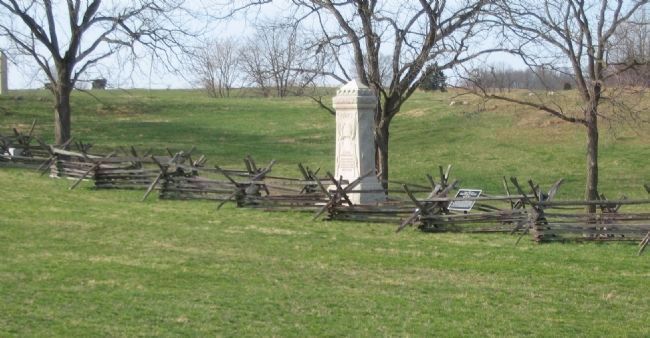
Photographed By Craig Swain, March 29, 2008
7. 8th Ohio Infantry Monument along the Sunken Road
Shortly after reaching the Sunken Road, the 8th Ohio and several other regiments were forced to turn and face north as new threats developed. A counterattack that included Manning's (Walker's) Confederate brigade broke through from the Hagerstown Pike and nearly turned French's Division flanks in this area.
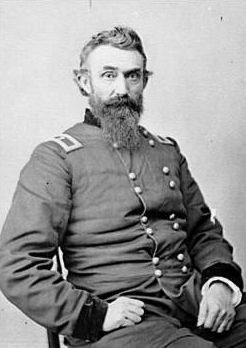
Photographed By Brian Scott
9. Brig. General Nathan Kimball (1822-1898)
His brigade formed the right of the division during its series of assaults on the Sunken Road at the Battle of Antietam, losing over 600 men killed or wounded. Despite the severe losses, the men held their ground and eventually pushed aside the Confederates in their front, capturing 300 men and several colors. Kimball's brigade became known as the "Gibraltar Brigade" for their steadfast ability to withstand enemy fire.
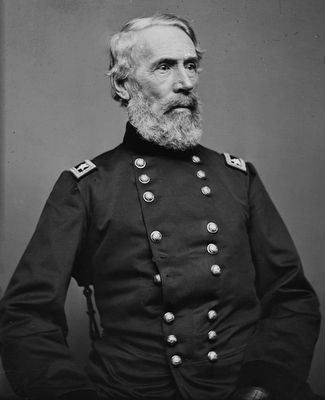
Photographed By Brian Scott
11. Gen. Edwin V. Sumner
In February 1861, Brig. Gen. David E. Twiggs was dismissed from the Army for treason by outgoing U.S. President James Buchanan, and on March 12, 1861, Sumner was nominated by the newly inaugurated Lincoln to replace Twiggs as one of only three brigadier generals in the regular army, with date of rank March 16. Sumner was thus the first new Union general created by the secession crisis. At Antietam, he commanded the II Corps.
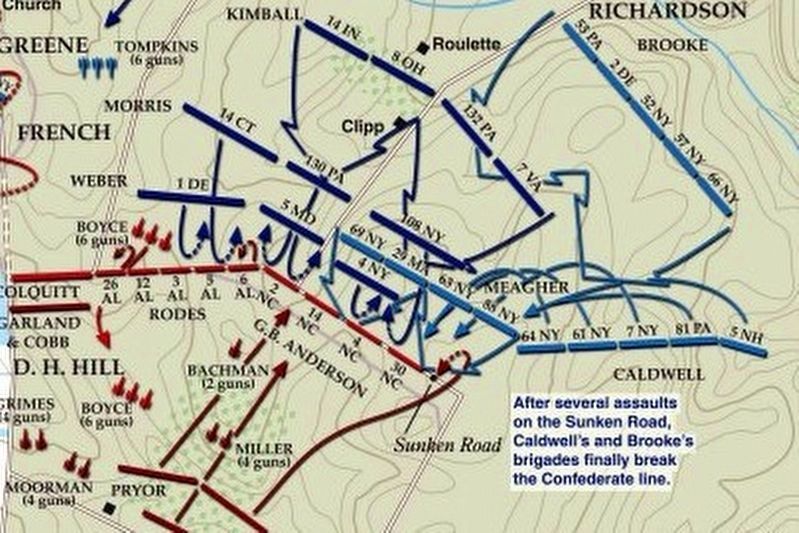
via American Battlefield Trust, unknown
13. Sunken Road or Bloody Lane Virtual Tour by Markers.
A collection of markers interpreting the action of during the Battle of Antietam around the Sunken Road.
(Submitted on February 23, 2008, by Craig Swain of Leesburg, Virginia.)
Click for more information.
(Submitted on February 23, 2008, by Craig Swain of Leesburg, Virginia.)
Click for more information.
Credits. This page was last revised on April 5, 2022. It was originally submitted on February 18, 2008, by Craig Swain of Leesburg, Virginia. This page has been viewed 1,388 times since then and 20 times this year. Photos: 1, 2. submitted on February 18, 2008, by Craig Swain of Leesburg, Virginia. 3. submitted on September 27, 2015, by Brian Scott of Anderson, South Carolina. 4. submitted on February 18, 2008, by Craig Swain of Leesburg, Virginia. 5. submitted on September 27, 2015, by Brian Scott of Anderson, South Carolina. 6. submitted on February 18, 2008, by Craig Swain of Leesburg, Virginia. 7. submitted on April 5, 2008, by Craig Swain of Leesburg, Virginia. 8, 9, 10, 11. submitted on September 27, 2015, by Brian Scott of Anderson, South Carolina. 12. submitted on November 24, 2010, by Bill Coughlin of Woodland Park, New Jersey. 13. submitted on April 3, 2022, by Larry Gertner of New York, New York.
